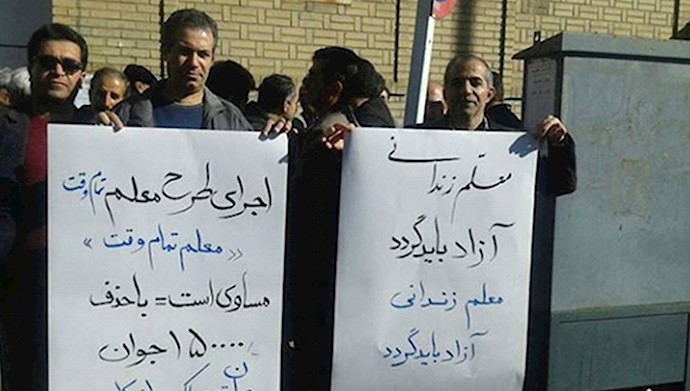Reported by PMOI/MEK
Iran, Feb. 16, 2019 – On Thursday, teachers and educators in several provinces in Iran held strikes. This was the fourth strike of Iranian teachers in the past year. According to declarations made by the organizers of the strike, the event would be held in six provinces.

Declaration of protests by Iranian teachers as seen on social media.
The top demand of the teachers is the release of their detained colleagues, teachers who have been incarcerated by the Iranian regime because of their activism and raising their voice for the rights of teachers and other segments of the Iranian society.
In Thursday’s protests, the teachers were holding placards that read, “In a country where teachers are behind bars, we can only weep blood.”
Another demand of the teachers is the cancelling of the “full-time teacher” plan. The plan, which was announced last year, will consider teachers as being in the employment of the government during the entire day, even outside teaching hours. While putting strain on teachers, many of whom are already doing other work to make ends meet, the plan bars the way for tens of thounsands of people who can become teachers.
During the Iran-Iraq war, the Iranian regime implemented an “honor teaching” plan, which forced teachers to teach two hours per week without pay. It was later passed into law. Teachers’ wages are already low to begin with, not even enough to provide the minimum needs of a decent life. Now, with the “full-time teacher” plan, regime officials are slowly forcing teachers into full service to avoid hiring more teachers.
But the teachers of Iran are well-organized and also very thoughtful. They’re insisting that the young generation of Iran must be provided with the right opportunities to help build the future of the country. They created an environment of national solidarity by persisting on their demands and have played a prominent role in the protests that erupted across Iran at the end of 2017.
Other demands of the protesting teachers include the following:
- Increase of wages : Iranian teachers make an average $100 per month, which is much less than the regime’s own declared poverty line.
- Respect to teachers’ dignity and position: The regime has regularly cracked down on teachers’ protests instead of listening to their demands.
- Free education: The teachers are demanding free education for the youth of Iran to ensure future generations have the capacity to lead the country.
- Balancing of pension funds and retirement wages: Retired teachers are struggling to provide their livelihoods while the regime had promised to see to their needs. They’re demanding improved pay for retired teachers.
In the past months, teachers have gone on strike on several occasions in protest to their conditions. The protests have expanded to many of the provinces of Iran.
Some of these nationwide protests include the following:
- In May, Iranian teachers held strikes in 34 cities
- In October, a second round of strikes by Iranian teachers, which lasted for two days, expanded to 103 cities
- In November, the teachers held another strike, with participants in all Iranian provinces
- In December, teachers and students in Hamedan and Kermanshah held demonstrations
- Shortly after, teachers in Isfahan and Yazd held protests. A few days later, teachers in Tabriz held demonstrations in spite of the freezing cold.
As the trend shows, protests by Iranian teachers are becoming more frequent, organized and expansive. The regime has tried to intimidate the protesters through suppression and violence. In December, security forces attacked teachers protesting in Isfahan. During Thursday’s protests, the regime had dispatched plainclothes agents to disperse and threaten the teachers. But so far, the regime’s repressive measures have proved fruitless in dissuading teachers from continuing to fight for their just rights.
When viewed in the context of other ongoing protests across Iran, the courage and determination of Iranian teachers are fueling and assisting other communities that are protesting for their most basic rights, such as workers, truck drivers, farmers and merchants.
Overall, as the nationwide uprisings that began in 2017 continue, the people of Iran are developing a spirit of solidarity, and with the help of organized resistance units, they’re inching toward achieving their ultimate demand which is to topple the dictatorship ruling their country and replace it with a democratic state.





